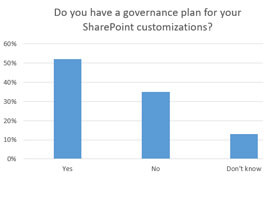At my first European SharePoint Conference in Berlin, I presented a session on SharePoint’s social media scorecard, discussing where the 2010 platform performed — and underperformed — around core social collaboration features in comparison to direct and indirect competitors. In the couple years since that event, its amazing to look back at how much not only the technology has advanced, but also at how the messaging around the social organization has begun to take hold. Microsoft has put social at the forefront of their strategy (along with cloud, mobile, and BI) as more and more organizations are recognizing the ability of social tools to drive adoption and engagement. But in a world that is moving fast towards a ‘social enterprise’ by supporting employee productivity through streamlined information sharing capabilities, I am concerned about the general lack of governance across our social platforms — and specifically within SharePoint, Office365, and Yammer.
I suppose it’s a fair question to ask — is this really even an issue for most organizations? Within enterprise content management (ECM) platforms, your ability to closely manage the content lifecycle, track and manage permissions, establish compliance and reporting standards, and automate many aspects of the platform are essential to meeting corporate governance requirements, and, for some, legal and regulatory requirements for the management of some data types. Lack of governance continues to be the number one constraint for those CIOs reluctant to move toward social solutions, and yet end users are rapidly adopting the tools. Companies are struggling with how to answer this growing social governance gap, with many organizations beginning to recognize the link between these social capabilities and dramatic improvements in end user adoption and engagement. And if more end users are on the platform, the sooner you’ll see a return on your collaboration investments.
This is not an issue that only impacts your decisions on moving to Yammer or Office365 — change is coming to all of your enterprise applications, from customer relationship management (CRM) platforms to your online banking experience. Social features, and the cloud infrastructures they are usually built upon, are helping services in almost every category to provide stronger connections between sales and support organizations and their customers, and between peer users through self-service communities.
Hopefully this movement toward social and the cloud is not a surprise to anyone. Certainly, Microsoft has been talking about it for a couple years now. Personally, I’ve written many articles that talk about the change that some organizations are experiencing due to Microsoft’s movements toward the cloud, and yet only 2 years ago, most people were complaining that Microsoft was not moving fast enough toward the cloud. In a whitepaper entitled Governance and Administration for Hybrid Deployments, SharePoint MCM Chris Beckett (@sharepointbits) pointed to the growing focus on governance of social and the cloud:
“Cloud computing provides an opportunity to move commodity infrastructure and services to cloud-based services managed by some of the world’s leading technology companies, reducing risk and optimizing resource utilization. As infrastructure and services increasingly are distributed across public, managed and private cloud environments, the need for sophisticated tools to support Governance and Administration will be essential.”
SharePoint 2013 social features mostly rely on data within an end user’s personal site and distributed cache, and use two primary lists — the Microfeed List and the Social List. Think about the complexity of the newsfeed alone (whether in SharePoint on premises or within Office365), and how your compliance and governance standards may be impacted. The micro-feed enables users to:
• Participate in conversations by posting comments and replies
• Post pictures and links
• Use tags (starting with the # symbol) to define keywords that users can follow and search for
• Use mentions (starting with the @ symbol) to tag users in posts and replies
• Follow people, documents, sites, and tags to customize their feed
For some, the very thought of trying to apply governance standards to social collaboration runs counter to the idea of social. Your use cases for SharePoint are likely very different from your Yammer use cases, for example. However, the governance rules that guide how your organization builds out any collaboration platform must be consistent. Social is more than just technology — it’s a cultural shift in how many organizations connect and work and innovate. As Microsoft says, its about People, Process and Technology. It’s about solving a business problem – but with an understanding of your cultural needs. But part of that cultural “fit” is understanding the governance and administration requirements of tools and systems within your organization.
Governance should be a priority no matter what tools or platform you deploy, but certainly should be at the forefront of any decisions to roll out company-wide social tools. My recommendation is to begin by clarifying and documenting your permissions, information architecture, templates, content types, taxonomy within SharePoint — and ownership of each — and then map those requirements to your social roadmap. Define what policies, procedures, and metrics are necessary to manage your entire environment (of which social collaboration is just a piece), and then look at what is possible across your social tools and platforms. Microsoft is working tirelessly to provide both out-of-the-box administration and automation capabilities to SharePoint on premises, SharePoint Online via Office365, and to Yammer — but how your requirements map to what is available today should be part of your decision-making process on how to move forward.
If you’re interested in hearing more on this topic, please check out the webinar I did for the European SharePoint Conference community, available in the community resources on this site.
If you have any questions or feedback on Christian’s article please leave a comment below. We would love to hear from you.
See Christian Buckley speak on social, What It Takes to Make Social Successful.

Christian Buckley
Christian Buckley is a SharePoint MVP, internationally recognized author and speaker, and a Forbes Top 25 SharePoint Influencer. As Metalogix’s evangelist, he drives product awareness and community development. He was part of the Microsoft team that launched SharePoint Online (now part of Office365), and worked with some of the world’s largest technology companies to build and deploy social, collaboration, and supply chain solutions. Co-author of Microsoft SharePoint 2010: Creating and Implementing Real-World Projects (MSPress) and 3 books on software configuration management, Christian is president of IAMCP Seattle, is part of AIIM.org’s Executive Leadership Council, and can be found online at www.buckleyplanet.com and @buckleyplanet











